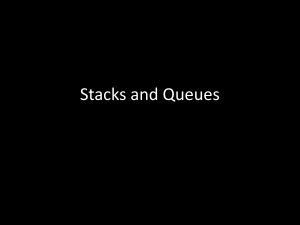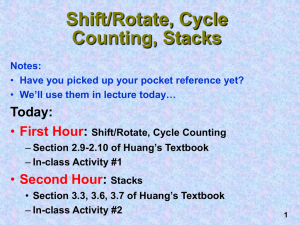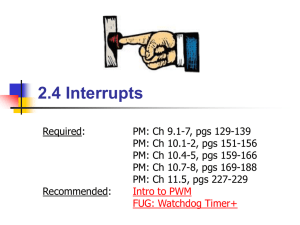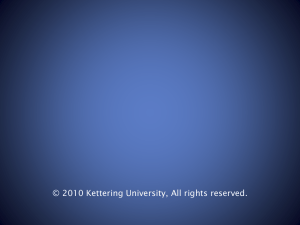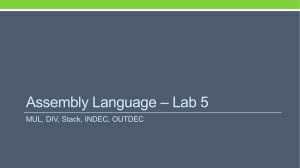Chapter 08 - Stacks
advertisement
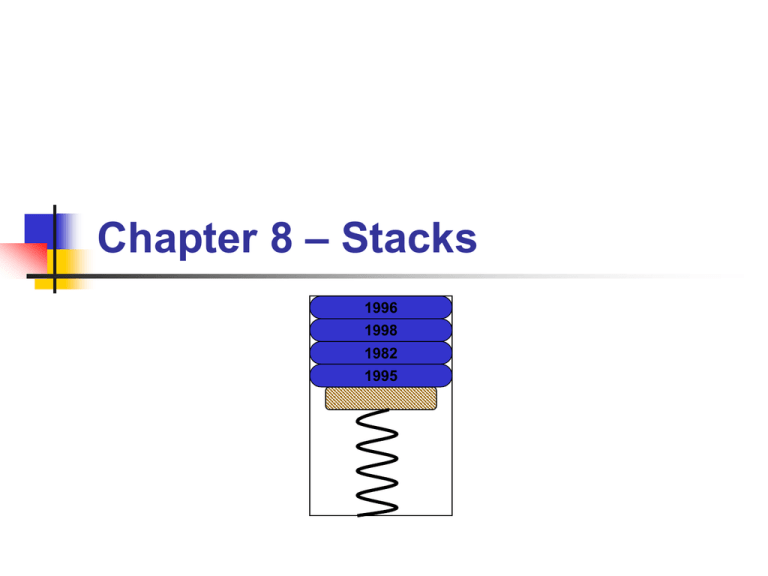
Chapter 8 – Stacks 1996 1998 1982 1995 Topics to Cover… The Stack Subroutines Subroutine Linkage Instruction Timing Stoplight Example Saving Registers Stack Operations Recursive Subroutines Activation Records BYU CS/ECEn 124 Chapter 8 - Stacks 2 Levels of Transformation Problems Algorithms Language (Program) Programmable Machine (ISA) Architecture Computer Specific Microarchitecture Manufacturer Specific Circuits Devices BYU CS/ECEn 124 Chapter 8 - Stacks 3 The Stack Stacks Stacks are the fundamental data structure of computers today A stack is a last in, first out (LIFO) abstract data type A stack is a restricted data structure with two fundamental operations, namely push and pop Elements are removed from a stack in the reverse order of their addition BYU CS/ECEn 124 Chapter 8 - Stacks 4 The Stack MSP430 Stack Hardware support for stack Register R1 – stack pointer Initialized to highest address of RAM MSP430F2013 0x0280 (128 bytes) MSP430F2274 0x0600 (1k bytes) Stack grows down towards low addresses Initialize stack at beginning of program STACK .set 0x0600 ; top of stack mov.w #STACK,SP BYU CS/ECEn 124 ; Initialize stack pointer Chapter 8 - Stacks 5 The Stack MSP430 Stack Stack pointer holds the address of the top of the stack The lsb of the stack pointer is always 0 PUSH, POP, CALL, RET, and RETI instructions use the stack pointer The stack is used for saving return addresses, local variable storage, and interrupts BYU CS/ECEn 124 Chapter 8 - Stacks 6 The Stack Computer Memory – Up or Down? x0000 Up Down xFFFF BYU CS/ECEn 124 xFFFF Down Up x0000 Chapter 8 - Stacks 7 Subroutines Subroutines A subroutine is a program fragment that performs some useful function. Specific functions that only apply to one program Provides a way to organize the program. Performs a specific task. Relatively independent of the remaining code. Keeps the program smaller (no need to repeat code). Smaller programs are easier to maintain. Reduces development costs while increasing reliability. Fewer bugs – copying code repeats bugs. Often collected into libraries. BYU CS/ECEn 124 Chapter 8 - Stacks 8 Subroutines The Call / Return Mechanism BYU CS/ECEn 124 Chapter 8 - Stacks 9 Subroutine Linkage Stack Operations Single operand instructions: Mnemonic Operation Description PUSH(.B or .W) src SP-2SP, src@SP Push byte/word source on stack CALL SP-2SP, PC+2@SP dstPC Subroutine call to destination TOSSR, SP+2SP TOSPC, SP+2SP Return from interrupt dst RETI Emulated instructions: Mnemonic Operation Emulation Description RET @SPPC SP+2SP MOV @SP+,PC Return from subroutine POP(.B or .W) dst @SPtemp SP+2SP tempdst MOV(.B or .W) @SP+,dst Pop byte/word from stack to destination BYU CS/ECEn 124 Chapter 8 - Stacks 10 Subroutine Linkage Subroutine linkage A subroutine is “called” in assembly with a CALL instruction. The address of the next instruction after the subroutine call is saved by the processor onto the stack. Local variables are pushed/popped from the stack. At the end of a subroutine, a RET instruction “pops” the top value from the stack into the program counter. BYU CS/ECEn 124 Chapter 8 - Stacks 11 Subroutine Linkage “Calling” a Subroutine Push PC+2 on the stack and move the source to the PC: CALL #TONI Instruction code: 0x000100101 Op-code call b/w 16-bits Ad Immediate D-reg PC 000100101 0 11 0000 16-bit Destination Address This instruction uses 2 words Decrement the Stack Pointer (R1) by 2, store the Program Counter (PC) + 2 indirectly through the Stack Pointer, and then store the 16-bit, immediate value in the Program Counter (PC) The 16-bit address is stored in the word following the instruction. BYU CS/ECEn 124 Chapter 8 - Stacks 12 Subroutine Linkage Return from Subroutine Pop the stack into the Program Counter: RET ; MOV @SP+,PC Instruction code: 0x4130 Op-code mov S-reg SR Ad Register b/w 16-bits As Indirect + D-reg PC 0100 0001 0 0 11 0000 This emulated instruction uses 1 word The instruction directs the CPU to move the value indirectly pointed to by the Stack Pointer (R1) into the Program Counter (PC) and then increment the Stack Pointer by 2. BYU CS/ECEn 124 Chapter 8 - Stacks 13 Subroutine Linkage Caution… The destination of branches and calls is used indirectly, and this means the content of the destination is used as the address. Errors occur often when confusing symbolic and absolute modes: ; Subroutine’s address is stored in MAIN ; Subroutine starts at address MAIN The real behavior is easily seen when looking to the branch instruction. It is an emulated instruction using the MOV instruction: CALL MAIN CALL #MAIN BR MAIN ; Emulated instruction BR MOV MAIN,PC ; Emulation by MOV instruction The addressing for the CALL instruction is exactly the same as for the BR instruction. BYU CS/ECEn 124 Chapter 8 - Stacks 14 Instruction Timing Cycles Per Instruction... Instruction timing: 1 cycle to fetch instruction word +1 cycle if source is @Rn, @Rn+, or #Imm +2 cycles if source uses indexed mode 1st to fetch base address 2nd to fetch source Includes absolute and symbolic modes +2 cycles if destination uses indexed mode +1 cycle if writing destination back to memory BYU CS/ECEn 124 Chapter 8 - Stacks 15 Instruction Timing Cycles Per Instruction... Src Dst Rn Rm 1 1 MOV R5,R8 @Rm 2 1 MOV R5,@R6 x(Rm) 4 2 ADD R5,4(R6) EDE 4 2 XOR R8,EDE &EDE 4 2 MOV R5,&EDE #n x(Rm) 5 3 MOV #100,TAB(R8) &TONI &EDE 6 3 MOV &TONI,&EDE BYU CS/ECEn 124 Cycles Length Example Chapter 8 - Stacks 16 Instruction Timing Quiz Given a 1.2 mhz processor, what value for DELAY would result in a 1/2 second delay? DELAY .equ mov.w ??? #DELAY,r12 delay1: dec.w jn mov.w r12 delay3 #1000,r15 delay2: dec.w jne jmp r15 delay2 delay1 delay3: BYU CS/ECEn 124 Chapter 8 - Stacks 17 Instruction Timing Quiz (cycles) Given a 1.2 mhz processor, what value for DELAY would result in a 1/2 second delay? DELAY .equ mov.w ??? #DELAY,r12 ; 2 cycles delay1: dec.w jn mov.w r12 delay3 #1000,r15 ; 1 cycle ; 2 cycles ; 3 cycles delay2: dec.w jne jmp r15 delay2 delay1 ; 3 x 1000 ; = 3000 cycles ; 2 cycles delay3: BYU CS/ECEn 124 Chapter 8 - Stacks 18 Instruction Timing Quiz (answer) Known equates: Delay time in cycles: 1 second = 1,200,000 cycles 0.5 seconds = 1,200,000 / 2 = 600,000 cycles ((DELAY x 3008) + 3) cycles = 600,000 cycles Hence: 600000 – 3 DELAY = ---------3008 = 199.467 = 199 BYU CS/ECEn 124 Chapter 8 - Stacks 19 Stoplight Example Stoplight Lab Determine the clock speed of your MSP430F2013 (or F2274) processor. Use these calculations to program software timing loops for you traffic light. Turn on the green LED for 5 seconds. Blink the green LED on and off at 1 second intervals for 6 seconds (3 off’s and 3 on’s). Blink the green LED on and off at 0.25 second intervals for 4 seconds (8 off’s and 8 on’s). And finally, turn the green LED off for 10 seconds. The total traffic light cycle time should be 25 seconds. Repeat the stoplight cycle indefinitely. BYU CS/ECEn 124 Chapter 8 - Stacks 20 Stoplight Example Stoplight Lab ;*********************************************************************** ; CS/ECEn 124 Lab 1 - blinky.asm: Software Toggle P1.0 ; ; Description: Toggle P1.0 by xor'ing P1.0 inside of a software loop. ;*********************************************************************** .cdecls C,LIST, "msp430x20x3.h" ; MSP430F2013 ; .cdecls C,LIST, "msp430x22x4.h" ; MSP430F2274 ;---------------------------------------------------------------------.text ; beginning of code RESET: mov.w #0x0280,SP ; init stack pointer mov.w #WDTPW+WDTHOLD,&WDTCTL ; stop WDT bis.b #0x01,&P1DIR ; set P1.0 as output mainloop: xor.b mov.w #0x01,&P1OUT #0,r15 ; toggle P1.0 ; use R15 as delay counter delayloop: dec.w jnz jmp r15 delayloop mainloop ; delay over? ; n ; y .sect .short .end ".reset" RESET ; MSP430 RESET Vector ; start address BYU CS/ECEn 124 Chapter 8 - Stacks 21 Stoplight Example Stoplight Lab DELAY .cdecls C,LIST, "msp430x20x3.h" ; MSP430F2013 .equ (50/8) .text mov.w mov.w bis.b #0x0280,SP #WDTPW+WDTHOLD,&WDTCTL #0x01,&P1DIR mainloop: xor.b call jmp #0x01,&P1OUT #delay1sec mainloop ; toggle P1.0 delay1sec: mov.w #DELAY,r12 ; get delay count delay02: dec.w jeq mov.w r12 delay06 #0,r15 ; done? ; y, return ; n, use R15 as delay counter delay04: dec.w jnz jmp r15 delay04 delay02 ; delay over? ; n ; y delay06: ret ".reset" RESET ; MSP430 RESET Vector ; start address RESET: .sect .short .end BYU CS/ECEn 124 ; ; ; ; Chapter 8 - Stacks beginning of code init stack pointer stop WDT set P1.0 as output 22 Saving Registers Saving and Restoring Registers Called routine -- “callee-save” Calling routine -- “caller-save” At beginning of routine, save all registers that will be altered (unless altered value is desired by calling program!) Before returning, restore those same registers in reverse order If registers need to be preserved across subroutine calls, save before calling routine and restore upon returning from routine Or, avoid using those registers altogether Values are saved by storing them in memory, preferably on the stack. BYU CS/ECEn 124 Chapter 8 - Stacks 23 Saving Registers Caller-Save vs. Callee-Save Save Registers call subroutine Save Registers subroutine call subroutine Restore Registers BYU CS/ECEn 124 subroutine Restore Registers Chapter 8 - Stacks 24 Stack Operations Stack Operations Single operand instructions: Mnemonic Operation Description PUSH(.B or .W) src SP-2SP, src@SP Push byte/word source on stack CALL SP-2SP, PC+2@SP dstPC Subroutine call to destination TOSSR, SP+2SP TOSPC, SP+2SP Return from interrupt dst RETI Emulated instructions: Mnemonic Operation Emulation Description RET @SPPC SP+2SP MOV @SP+,PC Return from subroutine POP(.B or .W) dst @SPtemp SP+2SP tempdst MOV(.B or .W) @SP+,dst Pop byte/word from stack to destination BYU CS/ECEn 124 Chapter 8 - Stacks 25 Stack Operations Push Operand Push the contents of register R5 on the stack: PUSH R5 Instruction code: 0x000100100 Op-code push b/w 16-bits Ad Register D-reg r5 000100100 0 00 0101 This instruction uses 1 word Decrement the Stack Pointer (R1) by 2 and store the destination value indirectly through the Stack Pointer Note: The stack pointer is always decremented by 2, whether a byte or word instruction. BYU CS/ECEn 124 Chapter 8 - Stacks 26 Stack Operations Pop Operand Pop the stack into the destination: MOV @SP+,R5 Instruction code: 0x4135 Op-code mov S-reg SP Ad Register b/w 16-bits As Indirect + D-reg r5 0100 0001 0 0 11 0101 This emulated instruction uses 1 word The instruction directs the CPU to move the value indirectly pointed to by the Stack Pointer (R1) into the destination and then increment the Stack Pointer by 2. BYU CS/ECEn 124 Chapter 8 - Stacks 27 Recursive Subroutines Recursive Subroutine A subroutine that calls itself is said to be a recursive subroutine Recursion allows direct implementation of functions defined by mathematical induction and recursive divide and conquer algorithms Factorial, Fibonacci, summation Binary search Reduces duplication of code. MUST USE STACK! BYU CS/ECEn 124 Chapter 8 - Stacks 28 Activation Records Activation Records A function is activated when called Save return address and call-ee registers Allocate memory for local variables An activation record is a template of the relative positions of its local variables in memory as defined by the function Activation records are allocated on the stack A frame pointer is used to indicate the start of the activation record Could use a dedicated register Or, more commonly, use the stack pointer BYU CS/ECEn 124 Chapter 8 - Stacks 29 Activation Records Activation Records A new activation record is created on the stack for each invocation of a function When the function completes and returns control to the caller, the activation record is discarded. An activation record may contain: Memory for local function variables Bookkeeping information Parameters passed to function from caller Saved registers BYU CS/ECEn 124 Chapter 8 - Stacks 30 Activation Records Example Example activation record (6 bytes): 4(SP) 2(SP) 0(SP) Return address Outer loop counter Inner loop counter delay1sec: sub.w mov.w #4,SP #DELAY,2(SP) ; activate 2 variables ; set delay count delay02: dec.w jeq mov.w 2(SP) delay06 #0,(SP) ; done? ; y, return ; n, init delay counter delay04: dec.w jnz jmp 0(SP) delay04 delay02 ; delay over? ; n ; y delay06: add.w ret #4,SP ; pop AR variables ; return from function BYU CS/ECEn 124 Chapter 8 - Stacks 31 BYU CS/ECEn 124 Chapter 8 - Stacks 32


